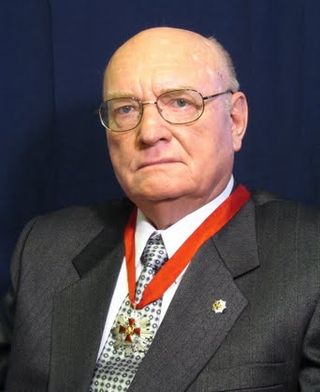
In mathematics, the Fibonacci sequence is a sequence in which each number is the sum of the two preceding ones. Numbers that are part of the Fibonacci sequence are known as Fibonacci numbers, commonly denoted Fn . Many writers begin the sequence with 0 and 1, although some authors start it from 1 and 1 and some from 1 and 2. Starting from 0 and 1, the sequence begins

In mathematics, two quantities are in the golden ratio if their ratio is the same as the ratio of their sum to the larger of the two quantities. Expressed algebraically, for quantities and with , is in a golden ratio to if

Fibonacci was an Italian mathematician from the Republic of Pisa, considered to be "the most talented Western mathematician of the Middle Ages".
In programming language theory, lazy evaluation, or call-by-need, is an evaluation strategy which delays the evaluation of an expression until its value is needed and which also avoids repeated evaluations.
In information theory, an entropy coding is any lossless data compression method that attempts to approach the lower bound declared by Shannon's source coding theorem, which states that any lossless data compression method must have an expected code length greater than or equal to the entropy of the source.
In mathematics and computing, Fibonacci coding is a universal code which encodes positive integers into binary code words. It is one example of representations of integers based on Fibonacci numbers. Each code word ends with "11" and contains no other instances of "11" before the end.
A low-level programming language is a programming language that provides little or no abstraction from a computer's instruction set architecture; commands or functions in the language are structurally similar to a processor's instructions. Generally, this refers to either machine code or assembly language. Because of the low abstraction between the language and machine language, low-level languages are sometimes described as being "close to the hardware". Programs written in low-level languages tend to be relatively non-portable, due to being optimized for a certain type of system architecture.
An Aggregate pattern can refer to concepts in either statistics or computer programming. Both uses deal with considering a large case as composed of smaller, simpler, pieces.
34 (thirty-four) is the natural number following 33 and preceding 35.
55 (fifty-five) is the natural number following 54 and preceding 56.
The FISH (FIbonacci SHrinking) stream cipher is a fast software based stream cipher using Lagged Fibonacci generators, plus a concept from the shrinking generator cipher. It was published by Siemens in 1993. FISH is quite fast in software and has a huge key length. However, in the same paper where he proposed Pike, Ross Anderson showed that FISH can be broken with just a few thousand bits of known plaintext.

In mathematics, Zeckendorf's theorem, named after Belgian amateur mathematician Edouard Zeckendorf, is a theorem about the representation of integers as sums of Fibonacci numbers.

In data compression, a universal code for integers is a prefix code that maps the positive integers onto binary codewords, with the additional property that whatever the true probability distribution on integers, as long as the distribution is monotonic (i.e., p(i) ≥ p(i + 1) for all positive i), the expected lengths of the codewords are within a constant factor of the expected lengths that the optimal code for that probability distribution would have assigned. A universal code is asymptotically optimal if the ratio between actual and optimal expected lengths is bounded by a function of the information entropy of the code that, in addition to being bounded, approaches 1 as entropy approaches infinity.
The Fibonacci numbers are a sequence of integers, typically starting with 0, 1 and continuing 1, 2, 3, 5, 8, 13, ..., each new number being the sum of the previous two. The Fibonacci numbers, often presented in conjunction with the golden ratio, are a popular theme in culture. They have been mentioned in novels, films, television shows, and songs. The numbers have also been used in the creation of music, visual art, and architecture.
Verner Emil Hoggatt Jr. was an American mathematician, known mostly for his work in Fibonacci numbers and number theory.
The Fibonacci Quarterly is a scientific journal on mathematical topics related to the Fibonacci numbers, published four times per year. It is the primary publication of The Fibonacci Association, which has published it since 1963. Its founding editors were Verner Emil Hoggatt Jr. and Alfred Brousseau; the present editor is Professor Curtis Cooper of the Mathematics Department of the University of Central Missouri.

In finance, Fibonacci retracement is a method of technical analysis for determining support and resistance levels. It is named after the Fibonacci sequence of numbers, whose ratios provide price levels to which markets tend to retrace a portion of a move, before a trend continues in the original direction.
In mathematics, a sequence of natural numbers is called a complete sequence if every positive integer can be expressed as a sum of values in the sequence, using each value at most once.
Dart is a programming language designed by Lars Bak and Kasper Lund and developed by Google. It can be used to develop web and mobile apps as well as server and desktop applications.

Alexey Petrovich Stakhov is a Ukrainian mathematician, inventor and engineer, who has made contributions to the theory of Fibonacci numbers and the "Golden Section" and their applications in computer science and measurement theory and technology. Doctor of computer science (1972), professor (1974). Author of over 500 publications, 14 books and 65 international patents.